Lincoln Center for the Performing Arts New York Ny Jazz Director
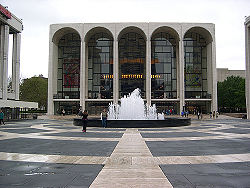
A view of the Metropolitan Opera House at Lincoln Center for the Performing Arts.
Lincoln Center for the Performing Arts is an extensive 16.three acres (66,000 m²) arts complex in New York City which contains the urban center's finest performing arts venues, and serves as a domicile for New York's oldest and best established performing companies. At the head of the complex's central courtyard is the Metropolitan Opera Business firm, flanked on the left past the New York State Theater, and on the right by Avery Fisher Hall. In add-on to an impressive roster of resident performing companies, the center is as well domicile to a specialized performing arts library, and top class dance and music training facilities.
Created with a vision of bringing together the best of New York's resident performing companies into 1 major performing arts center, Lincoln Center was conceived and designed kickoff in the 1950s. Ground was cleaved for the center in 1959, by President Dwight D. Eisenhower. The starting time theater, Philharmonic Hall (Avery Fisher Hall), is the main venue of the New York Philharmonic, opening in 1962. Information technology was followed by the New York Land Theater, resident theater to the New York City Opera and the New York City Ballet, in 1964. The Metropolitan Opera House, home to the Metropolitan Opera and site of the American Ballet Theater's annual Lincoln Center season, opened in 1966.
Contents
- 1 Overview
- ii History
- two.i Lincoln Centre for the Performing Arts, Inc
- 3 Performance facilities
- iii.one Other associated and local theaters and facilities
- 4 Resident organizations
- 5 Architects
- 6 Historical events
- vii In popular culture
- eight Legacy
- 9 Gallery
- 10 See also
- eleven Notes
- 12 References
- 13 External links
- 14 Credits
In addition to the three chief theaters, the eye contains a number of other significant venues and arts institutions, and provides a standard past which performing arts is measured throughout the U.s.a.. The telescopic and quality of Lincoln Middle'due south facilities, programs, and artistic companies is unequaled in any performing arts complex in the world. The performance arts tin can exert valuable, positive influences on people, contributing to their quality of life and well being. The center provides an environment that allows the arts to flourish and allows many people to experience quality performances. Lincoln Center makes a substantial contribution to the overall health of New York's residents and visitors.
Overview

A sign directing visitors to the various buildings at Lincoln Heart.
Lincoln Heart, an all-encompassing complex of performing, rehearsal, and educational facilities is located in Manhattan's upper due west side. The center contains a total of 22 functioning facilities, which nowadays thousands of performances every year, performed by resident companies, invited guest artists, and talented students from the center's educational institutions.
The eye is operated by a consortium of twelve major arts organizations, each with its own administration and board of directors, listed hither in alphabetical gild: Chamber Music Society of Lincoln Center, Pic Order of Lincoln Center, Jazz at Lincoln Center, Juilliard School, Lincoln Center for the Performing Arts, Inc., Lincoln Centre Theater, Metropolitan Opera, New York Metropolis Ballet, New York City Opera, New York Combo, New York Public Library for the Performing Arts, and School of American Ballet.
Beginning with initial plans in the 1950s, with the showtime facilities completing construction in the early on 1960s, Lincoln Heart has continuously expanded and developed both its facilities and programs, bringing together arts and cultures from all across the world, to present alongside the center'due south resident companies, totaling thousands of performances a year, created past thousands of artists.
The center too contributes to the economic stability of the upper west side, with the center'south resident companies, schools and arrangement providing jobs both in the arts and in a wide range of support fields, and drawing five million visitors a twelvemonth to the neighborhood.
History
A team of civic leaders and others led by, and under the initiative of John D. Rockefeller III, built Lincoln Middle equally part of the "Lincoln Foursquare Renewal Project" during Robert Moses' plan of urban renewal in the 1960s. Rockefeller was its inaugural president from 1956 and became its chairman in 1961. He is credited with raising more than half of the $184.5 1000000 in private funds needed to build the complex, including drawing on his own funds; the Rockefeller Brothers Fund also contributed to the project. The Lincoln Center was the largest and near aggressive arts project in the history of New York City, and indeed in the Usa.
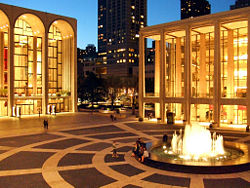
Avery Fisher Hall (right) and the Metropolitan Opera House at twilight
The center's plans included a new home for the Metropolitan Opera, the New York Land Theater, to be shared by the New York City Opera and the New York City Ballet, the Avery Fisher Hall, which became the home of the New York Combo, the Alice Tully Hall, and two theaters of drama. In order to create a resident nonprofit theater company to compliment the opera, ballet and orchestra, Repertory Theater of Lincoln Eye was founded in 1960. With the facilities all the same in the final planning stages and under construction, a training programme for a core of performers was initiated in 1962.[1] The company'south first product was Arthur Miller's After the Fall. The showtime two seasons presented repertory split betwixt new American plays and American and European classics, but was met with absurd critical reception, and the idea was abased for the time being. Reestablished in 1985, the theater company has flourished and at present goes but past the proper name of the Lincoln Eye Theater, offering a combination of musicals and dramas.[1] The Bedchamber Music Order of Lincoln Center was formed in 1965, and took residence in Alice Tully Hall.
Throughout the 1960s, the major facilities of Lincoln center were completed, with the initial circuitous reaching completion with the opening of the Juilliard School in 1969. Fundraising campaigns for upkeep, expansion and renewal began immediately, and facilities have been added renovated continuously throughout the middle's history.
Lincoln Heart cultural institutions too make use of facilities located away from the main campus. In 2004, Lincoln Center was expanded through the improver of Jazz at Lincoln Middle'due south newly built facilities (Frederick P. Rose Hall) at the new Fourth dimension Warner Eye, located a few blocks to the southward. In March 2006 Lincoln Center launched structure on a major redevelopment plan to modernize and renovate various parts of the Lincoln Centre campus facilities in preparation for the center's 50th anniversary commemoration in 2009. These include the 65th Street Project—part of a major redevelopment plan—to create a new pedestrian promenade designed to improve accessibility and the aesthetics of that area of the campus.[2]
Lincoln Center for the Performing Arts, Inc
Lincoln Center for the Performing Arts, Inc. is i of the 12 resident organization listed in a higher place, and serves three master roles: Presenter of artistic programming, national leader in arts and didactics and community relations, and manager of the Lincoln Center campus. Equally a presenter of more than than 400 events annually, its programs include American Songbook, Great Performers, Lincoln Eye Festival, Lincoln Center Out of Doors, Midsummer Nighttime Swing, the Mostly Mozart Festival, and the Emmy Award-winning Alive From Lincoln Middle. In July 2006, LCPA began work, in partnership with publishing visitor John Wiley & Sons, Inc. to publish at to the lowest degree fifteen books, focusing on performing arts, and drawing on Lincoln Center Plant'south educational background and archives.
Functioning facilities
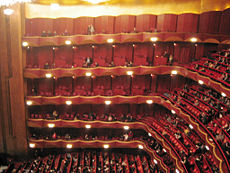
Auditorium of the Metropolitan Opera business firm
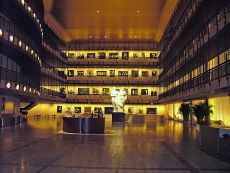
The lobby of the New York Country Theater
- The Metropolitan Opera House—3,900-seat opera business firm; home theater of the Metropolitan Opera, and used annually past American Ballet Theater for part of their New York season. This is the second Metropolitan Opera Firm; the original i opened in 1883 and was demolished in 1966, the yr of the opening of the new Metropolitan Opera facilities at Lincoln Center. The architect was Wallace K. Harrison of Harrison & Abramovitz.
- The New York Country Theater—2,713-seat theater opened April 23, 1964. The builder was Philip Johnson of Philip Johnson Associates. Originally constructed to be the home of the New York City Ballet, at present also serves as dwelling to the New York Metropolis Opera. Many Broadway musicals have likewise been revived there. Underwent acoustical renovations in 1982.
- Avery Fisher Hall—ii,738-seat symphony hall; home venue of the New York Philharmonic; opened September 23, 1962 as Philharmonic Hall. The builder was Max Abramovitz of Harrison & Abramovitz. Renamed Avery Fisher Hall in 1973 to commemorate a generous donation from Avery Fisher. Underwent acoustical improvements in 1976.
- Alice Tully Hall—1,095-seat concert hall located within the Juilliard Schoolhouse building, opened September xi, 1969; home venue for The Chamber Music Order of Lincoln Centre. The chief architect was Pietro Belluschi. The associate architects are Helge Westermann and Eduardo Catalano. In 1987, Alice Tully Hall besides became host to the Classical Jazz series. Expansion and other renovations to the hall were carried out betwixt 2007 and 2008.
- Vivian Beaumont Theater—1,080-seat Broadway-style theater opened October 14, 1965. The architect was Eero Saarinen of Eero Saarinen & Assembly. Operated since 1985 as the main stage of Lincoln Eye Theater. Previously occupied past The Repertory Theater of Lincoln Centre (1965-1973) and The New York Shakespeare Festival (1973-1977).
- Mitzi Due east. Newhouse Theater (originally known every bit the Forum when it opened October 14, 1965)—intimate 299-seat theater operated by Lincoln Center Theater for its Off-Broadway-style productions. Renamed the Mitzi E. Newhouse Theater in 1973.
- The Walter Reade Theatre—268-seat cinema, opened December 3, 1991; used past the Flick Club of Lincoln Center; features a raised dais used for post-screening filmmaker discussions. Since 1996, also domicile to Reel to Real for Kids, a program combining movie excerpts with alive music.
- Jazz at Lincoln Center—opened October eighteen, 2004, while a part of Lincoln Center, is located separately in the Frederick P. Rose Hall complex inside the Time Warner Center at Columbus Circumvolve. The architect is the firm of Rafael Vinoly Architects. It consists of the following functioning and related facilities:
-
- The Allen Room—508 seat amphitheater with 50-human foot glass wall overlooking Central Park; part of Jazz at Lincoln Middle'south facilities
- Lightheaded'southward Society Coca-Cola—nightclub-style venue in the Jazz at Lincoln Center facility; allows jazz to exist performed in its traditional venue
- Rose Theater—1,094-seat concert hall designed for jazz performances.
- Irene Diamond Pedagogy Centre—rehearsal, recording, and classroom facility at Jazz at Lincoln Center
Other associated and local theaters and facilities
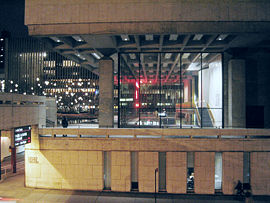
Night view of the Vivian Beaumont Theater, home of the Lincoln Center Theater company
- Church of St. Ignatius Loyola—Roman Catholic Church located on Park Avenue between 83rd and 84th Streets on the Upper East Side; used past Lincoln Center for its great acoustics and its piping organ (allowing expanded organ repertoire, since the Metropolitan Opera Firm and Alice Tully Hall are the only Lincoln Center venues with a pipe organ)
- Clark Studio Theater—120-seat dance theater; part of the facilities of the Lincoln Center Institute for the Arts in Education
- Damrosch Park—outdoor amphitheater with bowl-style stage known as the Guggenheim Band Shell, used for free Lincoln Center Out of Doors presentations
- Daniel and Joanna S. Rose Rehearsal Studio—rehearsal studio of The Sleeping accommodation Music Guild of Lincoln Heart
- The Gerald West. Lynch Theater at John Jay College—theater at John Jay College of Criminal Justice; used for the Lincoln Center Festival and Peachy Performers series
- Josie Robertson Plaza—central plaza of Lincoln Center featuring its iconic fountain; the three primary buildings (Metropolitan Opera Business firm, Avery Fisher Hall, and New York State Theater) confront onto this plaza; used as an outdoor venue during Midsummer Night Swing and Lincoln Eye Out of Doors presentations
- Juilliard Schoolhouse—facility housing the school of the aforementioned name; building likewise incorporates Alice Tully Hall, Morse Recital Hall, Paul Recital Hall, the Juilliard Drama Theater, and the Peter J. Abrupt Theater]]
- Peter J. Sharp Theater
- Morse Recital Hall—recital hall within the Juilliard School
- New York Public Library for the Performing Arts
- Paul Recital Hall—recital hall within the Juilliard School
- Pope Auditorium—theater located in Leon Lowenstein Hall of Fordham Academy's Lincoln Heart campus (located across West 62nd Street from Lincoln Heart)
- Stanley H. Kaplan Penthouse—nightclub-style venue; used for intimate concerts, "Meet the Artist" and Great Performers events, lectures, and other events where a small-scale, intimate space is preferred; was too used for jazz performances prior to the construction of the new Jazz at Lincoln Center facilities
Resident organizations
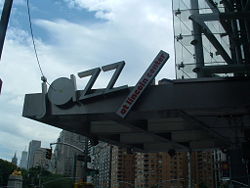
The entrance to Jazz at Lincoln Eye
Lincoln Eye houses several cultural companies and institutions, including:
- American Ballet Theatre, while not a resident company at Lincoln Eye, presents almanac seasons in Lincoln Center's Metropolitan Opera Business firm. The company was founded in 1937, and performs an extensive repertory of classical ballet works from acme choreographers from all effectually the world.
- The Chamber Music Guild of Lincoln Center was formed in 1965, as Lincoln Center was being constructed, and presented its outset concert in 1969. Resident in Alice Tully hall, the gild has a roster of 35 full time musicians, and performs a diversity of bedchamber repertory, dating as far back as the Renaissance. CMS has also commissioned more than than 135 new works from contemporary composers, including Bruce Adolphe, Samuel Barber, Leonard Bernstein, William Bolcom, John Corigliano, George Nibble, Lukas Foss, John Harbison, Alberto Ginastera, Morton Gould, Keith Jarrett, Oliver Knussen, Gian Carlo Menotti, Darius Milhaud, Peter Schickele, Vivid Sheng, Joan Belfry, and Ellen Taaffe Zwilich.
- Film Social club of Lincoln Eye (sponsor of the New York Film Festival) was founded in 1969. Resident in the Walter Reade Theater, the Film Society focuses on spotlighting American independent and new filmmakers. The club has also introduced a number of acclaimed foreign filmmakers to the U.S. motion picture public, produces an annual Gala Tribute recognizing U.South. film personalities of exceptional accomplishment, and publishes a bi-monthly journal, Film Comment.
- Jazz at Lincoln Center became a constituent fellow member of Lincoln Center in 1996. Eight years later, they now accept their own dedicated facility at Columbus Circumvolve, with three functioning venues, The Allen Room, Empty-headed's Guild Coca-Cola, and the Rose Theater. Jazz at Lincoln Middle produces over 3000 events a year, including performances, children'southward concerts, adult education and broadcast events, also equally providing a variety of musical grooming programs in jazz.
- The Juilliard School is a professional performing arts conservatory, with about 800 undergraduate and undergraduate students in music, trip the light fantastic toe and drama. The Juilliard School was founded in 1905, and moved to its current Lincoln Center campus in 1969. The school provides a large number of performance opportunities to students with a number of school performance ensembles.
- Lincoln Center for the Performing Arts, Inc., in add-on to providing overall coordination and oversight for the entire Lincoln Centre complex, presents more than 400 performances a twelvemonth through the Lincoln Middle Presents program. Lincoln Center Presents invites artists from around the world, including well established artists and newcomers, presenting performances in the centre's major and pocket-sized venues, as well as in the courtyards and on temporary stages during the summer months.
- Lincoln Center Theater, since its institution in 1985, has presented musicals and dramas in the Vivian Beaumont Theater, the Mitzi Eastward. Newhouse Theater, and other venues.
- The Metropolitan Opera, founded in 1880, and resident in Lincoln Center's Metropolitan Opera Business firm since 1966, presents near 240 opera performances each year, consisting of about 30 different productions annually. The company's roster of artists includes a large orchestra, chorus, dancers, children's chorus and an international roster of solo singers. The Met is known for the quality of its productions, both musical and in product elements.
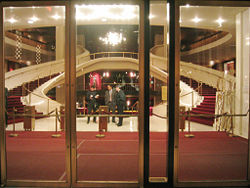
Staircase in the Metropolitan Opera House
- New York Metropolis Ballet, with a big roster of more than ninety dancers, and a agile repertory of more than 150 works, was founded in 1946 with choreographer George Balanchine equally ballet master in chief. Balanchine created most of his impressive opus of works for the New York City Ballet, where he remained until his death in 1983. Jerome Robbins and Peter Martins accept also choreographed numerous works for the company. Balanchine was involved in the design of the New York State Theater, which has been the company'due south home since it opened in 1964. New York City Ballet has also had a permanent summer home at The Saratoga Performing Arts Center since 1966.
- New York City Opera, resident in the New York State Theater, was founded in 1944 with a goal of making opera accessible to as wide a public equally possible. NYCO continues to pursue this goal with performances throughout the five boroughs, and was the first U.South. opera company to employ supertitles to assist audiences in post-obit the libretto and story every bit they watch productions. The company features American singers and composers.
- New York Philharmonic, founded in 1842, is the oldest orchestra in the United States. The orchestra has taken the lead in presenting new compositions by composers such equally Dvorak, Rachmaninoff, Gershwin, and many others. In addition to alive concerts, the orchestra has also made more than 2000 recordings since 1917. The New York Philharmonic roster of more than 100 fine musicians play its flavor of more than 150 concerts in Avery Fisher Hall each twelvemonth.
- New York Public Library for the Performing Arts, located at Lincoln Center, is part of the New York Metropolis library system, and features an all-encompassing audio and video collection of musical and theatrical performances.
- School of American Ballet is the official school of the New York City Ballet, and is located at Lincoln Center.
Each organization has its own board of directors and assistants. Together, they nowadays thousands of performances, educational programs, tours, and other events every year.[3]
Architects
Architects who designed buildings at Lincoln Center include:
- Max Abramovitz—Avery Fisher Hall
- Pietro Belluschi—The Juilliard School (including Alice Tully Hall)
- Gordon Bunshaft—The New York Public Library for the Performing Arts
- Wallace Harrison—Master plan & Metropolitan Opera House
- Philip Johnson—New York Land Theater
- Eero Saarinen—Vivian Beaumont Theater
Historical events

Nancy Rubins' Big Pleasure Betoken, brandish at Lincoln Middle in 2006
- April 21, 1955—Lincoln Square designated for urban renewal
- June 22, 1956—Lincoln Center for the Performing Arts, Inc. incorporated
- May fourteen, 1959—Ground breaking ceremony with President Dwight D. Eisenhower
- September 23, 1962—Philharmonic Hall (now Avery Fisher Hall) opened. A two-hour live CBS special, Opening Dark at Lincoln Center, preserved the issue on videotape
- Apr 6, 1964—Lincoln Heart Fountain opened
- Apr 23, 1964—New York State Theater opened
- October 14, 1965—Vivian Beaumont Theater and the Forum (now Mitzi East. Newhouse Theater) opened
- Nov xxx, 1965—The Library & Museum of the Performing Arts opened
- September xvi, 1966—The Metropolitan Opera House opened
- May 22, 1969—Damrosch Park and the Guggenheim Band Vanquish opened
- September 11, 1969—Alice Tully Hall opened
- October 26, 1969—Juilliard School opened
- October 19, 1976—Avery Fisher Hall re-opened after renovation to meliorate acoustics
- December four, 1981—The Large Apple Circus performed at its winter home in Damrosch Park for the get-go time. The circus has performed every wintertime at Lincoln Center ever since
- September seven, 1982—New York State Theater re-opened later renovation to improve acoustics
- September 2, 1986—Former Jewish Defence force League National Chairman Victor Vancier throws a tear gas grenade during a performance of Soviet ballet in the Metropolitan Opera Firm as a protest against the Soviet practice of non letting its Jews emigrate to State of israel
- Nov 19, 1990—The Samuel B. and David Rose Building opened; houses the Walter Reade Theater, the Stanley H. Kaplan Penthouse, the Daniel and Joanna S. Rose Rehearsal Studio, the Clark Studio Theater, and Juilliard School student residences, as well as office space for a number of the member organizations
- December iii, 1991—The Walter Reade Theater opened within the previously completed Samuel B. and David Rose Building
- July 12, 1997—The Paul Milstein Plaza dedicated
- October 18, 2004—Jazz at Lincoln Center opened
- March 2006—Preliminary construction on the West 65th Street Projection begins
- June 8, 2006—Plans for Lincoln Middle to transform the nearby Harmony Atrium into a public infinite for the arts open to the public, neighbors, students, and Lincoln Center patrons are appear
- June 12, 2006—The Lincoln Center Promenade initiative to revitalize Lincoln Center's Columbus Avenue frontage and the iconic Josie Robertson Plaza is unveiled
- Baronial 20, 2006—Paul Milstein Plaza dismantled as office of 65th Street Redevelopment project
In popular civilization
In popular civilization, in the 1990s PBS game prove Where in the World Is Carmen Sandiego? Robocrook steals Lincoln Center. The Center as well appears in the movies The Producers (1968 motion-picture show), August Blitz, Moonstruck, and Ghostbusters.
The middle has been seen many times on the Young People'due south Concerts, and is regularly featured on PBS'due south Live from Lincoln Center.
Legacy
The Lincoln Heart for the Performing Arts remains ane of the globe's leading presenters of performing arts. Its performances range from accurate kabuki theater and dance premieres from world-renowned choreographers, to outdoor dancing to live music, to opera performed with life-size puppets and costless performances of Korean drumming and African trip the light fantastic. In the 2007 flavor lonely, there were roughly 5000 performances by over 3000 artists, from every corner of the world.[3]
The Lincoln Center has won Emmy Awards for its Alive From Lincoln Eye telecasts. It remains a leader in arts and instruction, too as community relations, and takes a maintains a wide range of activities across its concert halls and through its education arm. The Lincoln Heart Institute offers arts-related symposiums, family unit programming, and other community initiatives. It also is responsible for providing curricula to educational institutions in in Australia, China, Mexico, and South Africa. The Lincoln Eye strives to make art from around the world accessible to everyone.[iii]
Gallery
-

The Metropolitan Opera House
-

View from above of a staircase at the Metropolitan Opera House
-

View of the Metropolitan Opera House auditorium
-

The New York Country Theater, home of New York Land Opera and New York Metropolis Ballet
-
An event at Jazz at Lincoln Center
-

Fountain in the master courtyard at Lincoln Center
-

Illusionist David Blaine in his Drowned Alive in the courtyard at Lincoln Center
-
The auditorium of the New York Country Theater
-

Avery Fisher Hall
-

Oversupply assembled for David Blaine'due south Drowned Alive
-

New York State Theater
-

Orchestra level seats in the New York Land Theater
-

Atrium of the New York State Theater
-

Avery Fisher Hall
Meet likewise
- Kennedy Heart
- Los Angeles Music Center
- Royal Opera House
- Palais Garnier
Notes
- ↑ ane.0 i.1 Answers.com, Lincoln Middle. Retrieved September 15, 2008.
- ↑ Robin Pogrebin, Glimpsing The Time to come On 65th St, New York Times, August 17, 2006. Retrieved September fifteen, 2008.
- ↑ 3.0 three.1 iii.2 Lincoln Center, Almost Lincoln Center. Retrieved September 15, 2008.
References
ISBN links support NWE through referral fees
- Holzer, Madeleine Fuchs, and Scott Noppe-Brandon. Community in the Making: Lincoln Center Institute, the Arts, and Teacher Educational activity. New York: Teachers College Press, 2005. ISBN 9780807745908.
- Stamas, Stephen, and Sharon Zane. Lincoln Center: A Hope Realized. Hoboken, North.J.: Wiley, 2007. ISBN 9780470101230.
- Young, Edgar B. Lincoln Center: The Edifice of an Institution. New York: New York University Printing, 1980. ISBN 9780814796566.
External links
All links retrieved July 23, 2018.
- Lincoln Eye official website
- American Ballet Theatre official website
- Chamber Music Order of Lincoln Center official website
- Film Society of Lincoln Eye official website
- Jazz at Lincoln Middle official website
- Lincoln Middle Theater official website
- Metropolitan Opera official website
- New York City Ballet official website
- New York Combo official website
- School of American Ballet official website
Credits
New World Encyclopedia writers and editors rewrote and completed the Wikipedia article in accordance with New World Encyclopedia standards. This article abides past terms of the Creative Commons CC-by-sa iii.0 License (CC-by-sa), which may be used and disseminated with proper attribution. Credit is due under the terms of this license that can reference both the New World Encyclopedia contributors and the selfless volunteer contributors of the Wikimedia Foundation. To cite this article click here for a list of acceptable citing formats.The history of before contributions by wikipedians is accessible to researchers hither:
- Lincoln Eye for the Performing Arts history
The history of this article since it was imported to New Earth Encyclopedia:
- History of "Lincoln Middle for the Performing Arts"
Note: Some restrictions may apply to utilise of individual images which are separately licensed.
counselolstoord93.blogspot.com
Source: https://www.newworldencyclopedia.org/entry/Lincoln_Center_for_the_Performing_Arts


0 Response to "Lincoln Center for the Performing Arts New York Ny Jazz Director"
Post a Comment